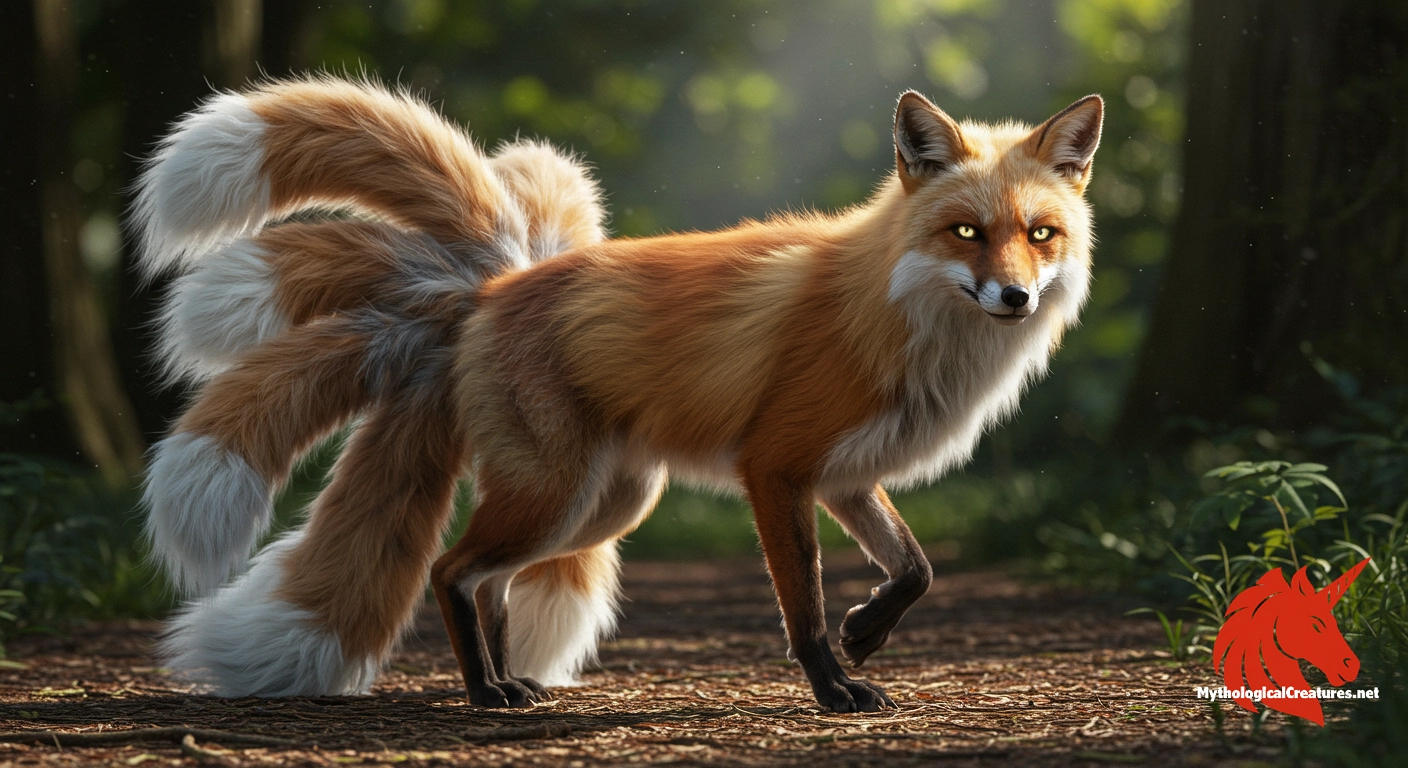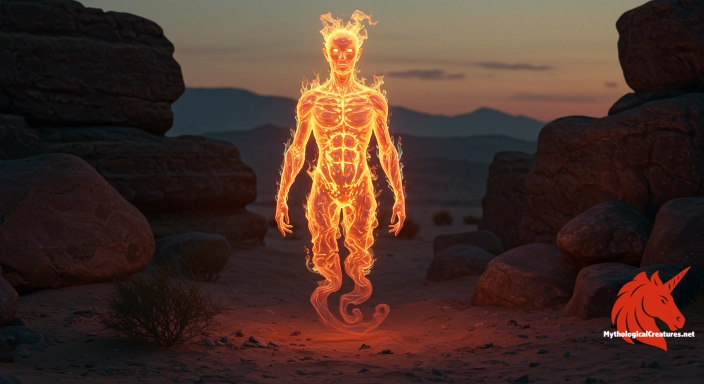Kitsune: Kitsune are fox spirits from Japanese folklore known for their shape-shifting abilities and cunning nature.

Kitsune
Kitsune - Kitsune embody the mystical relationship between nature, humans, and the divine in Japanese culture.
Origins & First Encounters
The kitsune are captivating mythological beings that have played a central role in Japanese culture for many centuries. They are renowned for their supernatural abilities that intensify with age, wisdom, and the growth of additional tails. Emerging from a deep well of folklore, these fox spirits present a fascinating duality as both mischievous tricksters and benevolent guardians. Their origins can be traced back to ancient times when the natural world and human civilisation were much more intertwined. Early tales depict the kitsune as enigmatic entities that could bridge the gap between the mundane and the magical. Their presence in rural narratives underscores the close bond between nature and human life in ancient Japan. In many accounts, their association with the Shinto deity Inari further highlights their role as sacred messengers and protectors. The evolving character of these spirits over time mirrors the dynamic nature of Japanese myth, making the kitsune a symbol of both mystery and wisdom. Additionally, the multiplicity of their tails serves as a metaphor for the layers of experience accumulated by these beings. Their enduring appeal continues to inspire artists and storytellers, reaffirming their significance in cultural identity.
Source Texts & Tale Variants
Narratives of the kitsune emerge from a vast array of sources, including ancient religious texts, local oral traditions, and later compilations of folklore. Early literary works and temple records hint at their supernatural feats and transformational abilities, painting a picture of a realm where the natural and the ethereal coalesce. Various regional folktales contribute nuanced interpretations of their character, with some tales focusing on their deceptive antics while others celebrate their role as loyal friends and guardians. Oral traditions preserved in village stories have added layers of detail to their myth, ensuring that the legacy of the kitsune continues to evolve. There are also written accounts that blend historical observation with mythic embellishment, creating a rich tapestry of narrative possibilities. Multiple versions of one story exist, each differing subtly but reinforcing the magical essence of the shapeshifter. Some texts pay particular attention to their connection with the divine, while others highlight their capacity for mischief. The diverse range of sources reflects the complexity and adaptability of the kitsune myth, making it a living tradition that continues to inspire curiosity and debate.
Form & Powers
The kitsune are typically depicted as foxes of remarkable beauty and agility, with sleek fur that seems to shimmer under the glow of the moon. Their coats are most commonly described in warm shades such as red or gold, though variations also include silvery and even dark, mysterious tones. A signature physical feature is the presence of multiple tails, with legends suggesting that each additional tail represents a further measure of wisdom and power. As a kitsune grows in age, not only do its tails multiply, but they also become larger and more intricately detailed, symbolising the creature’s deep-seated magical prowess. Their eyes are often described as luminous and penetrating, hinting at secrets beyond human comprehension. When assuming human form, the kitsune retain subtle traits—from an alluring smile to an enigmatic gaze—that betray their true nature. In some depictions, delicate, almost ethereal fur seems to glow faintly, as if imbued with otherworldly energy. The fluidity of their physical form, shifting gracefully from one appearance to another, underscores their role as creatures of transformation. Overall, the detailed physical portrayals of the kitsune serve to reinforce their mysterious charm and symbolic significance.
Regional Faces
The portrayal of the kitsune varies considerably across different regions of Japan, reflecting local beliefs and cultural practices. In rural communities, they are often seen as playful and elusive beings whose mischief can both enchant and befuddle villagers. In contrast, more urbanised areas tend to emphasise their spiritual association with Inari, venerating them as divine intermediaries. Certain regions hold annual festivals in their honour, where traditional rituals reaffirm the kitsune’s protective and benevolent aspects. Variations in storytelling have led to regional adaptations, with some areas highlighting their darker, more seductive traits and others celebrating their role as bringers of good fortune. Local shrine practices and ritual sacrifices also influence the perception of these fox spirits, blending folklore with religious devotion. These regional differences create a multifaceted image of the kitsune that is as diverse as Japan itself. Each local adaptation adds unique details, ensuring that the myth remains vibrant and continuously renewed over time.
Cultural Parallels
The kitsune share striking similarities with other shapeshifting and trickster figures found across different cultures worldwide. In Chinese folklore, for instance, the huli jing similarly embodies the dual nature of benevolence and cunning, often engaging in transformative acts that mirror those of the kitsune. Across the Korean peninsula, the kumiho—a nine‐tailed fox spirit—offers a darker counterpoint that underlines common themes of allure and danger in fox legends. Even within Japan, the legendary tanuki provides a fascinating contrast, as both creatures are celebrated for their shape-shifting prowess but are distinguished by their distinct symbolic roles. The recurring motif of multiple tails as a marker of growing power finds parallels in various Eastern traditions, underscoring a shared symbolic language. This comparative analysis not only highlights the kitsune’s unique attributes but also situates it within the broader context of global mythologies dealing with transformation and the supernatural. The exchange of cultural motifs between neighbouring societies reinforces the notion that these fox spirits speak to universal human fascinations with mystery and metamorphosis. Such cross-cultural resonances demonstrate that the legend of the kitsune is part of a wider tapestry of mythic archetypes that transcend national borders.
Legacy & Modern Evolution
The historical journey of the kitsune spans from ancient folklore to contemporary popular culture, reflecting the evolution of societal attitudes towards the supernatural. Over the centuries, these fox spirits have transitioned from enigmatic, awe-inspiring entities to dynamic symbols that influence modern media and art. Their role in religious practices, particularly within Shinto shrines dedicated to Inari, highlights an enduring connection between myth and ritual. As Japan modernised, literature, theatre, and later films began to reinterpret the kitsune in ways that captured both their mischievous and benevolent aspects. Today, the kitsune features prominently in anime, video games, and other facets of popular culture, where it is often depicted with a blend of ancient mystique and contemporary relevance. Modern portrayals continue to explore the complexities of transformation, deception, and loyalty, thus keeping the spirit of the myth alive. The evolution of the kitsune myth serves as a testament to the adaptability and resilience of traditional narratives in a changing world. Even as interpretations vary, the symbolism of the kitsune—as a bridge between the natural and the mystical—remains a potent reminder of the enduring allure of myth in modern society.
Interesting Fact
An interesting aspect of kitsune is their dual nature as both tricksters and protectors, which mirrors the unpredictable forces of nature itself.
Quick Creature Info
Associations:
Our Mythic Legendary Rating:

Also Sometimes Known As:
Habitat:
Supernatural Powers:
Physical Attributes:
Abilities:
Behavior:
Lore:
Related Creatures, Tales or Lore
- TTanuki
- HHuli jing
- KKumiho
References
Discover Another Mythical Legend You May Not Have Heard Of?
Uncover the mysteries of ancient folklore and expand your knowledge of legendary beings from cultures around the world.
Dare to Meet the Al-Jinn....
Mythical Disclaimer: The images and data on this site are derived from various historical and literary sources, but we have found that many myths often have multiple versions and interpretations across references, sometimes contradictory. As a result, these creature depictions are artistic interpretations—imaginative blends of folklore, legend, and a dash of AI guesswork. Because creature descriptions vary widely, our illustrations and accompanying information represent our best effort to honor mythology while bridging creative gaps. Enjoy these interpretations—just remember, we've done our best to respect the stories and validate available data, but in the realm of mythology, details often shift, imagination leads the way, and nothing is ever set in stone!
Curated by the Mythological Creatures Team (rev. May 2025)
